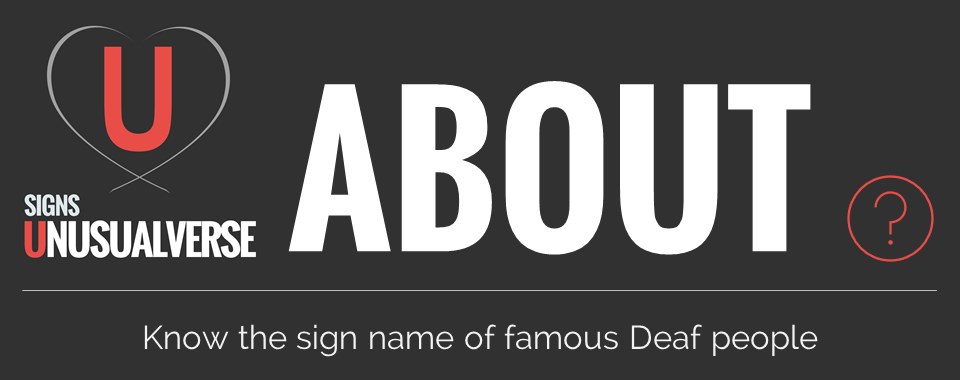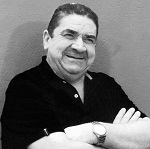
WHAT IS THIS?
As sign languages do not have a tradition of literacy, Deaf naming customs must survive mainly through collective memory […] Official records of Deaf schools, Deaf clubs, or Deaf sports groups or in Deaf publications, for example, document Deaf people’s English names but not their sign names. Linda Day & Rachel Sutton-Spence (2010)
What would the world be without Deaf people? What would the Deaf community be without memory? The contributions of Deaf people are numerous, their creativity and talent is amazing and the sign name is one of the most identifying features of the Deaf community and of Sign Language. Sign names must be preserved and the individual achievements of Deaf people all over the world must not be lost in oblivion.
This website is dedicated to collecting the sign names of Deaf people all over the world, as well as some prominent deafblind people.
Don’t forget to visit unusualverse.com
WHAT IS THE SIGN NAME?
One phenomenon reported from many sign language communities around the world is the use of so-called name signs (or, alternatively, sign names). A name sign is a sign that is used with reference to an individual and is normally used alongside a spoken language community name. Name signs are important as identity markers in the community because it is often a symbol of inclusion, that is, individuals with name signs are mostly those that are members of the community, although name signs are also given to individuals often talked about within the community without themselves being members, such as famous people or others with some relevance to the community. Carl Börstell (2017)
Origin
The origin and way of establishing sign name may vary culturally from some deaf communities to others but most research agrees on some points:
- In most Sign Languages, sign names can be arbitrary or descriptive.
- Usually, the sign name given to a person keeps it all life.
- Most of the time, the name sign is given by a deaf person.
- Often, the sign name is discussed and agreed in a group, as everyone should feel comfortable with the sign name.
- When a person joins the Deaf community after childhood, it is often called ‘baptism’.
Sign name in other languages
Sign name is also called name sign in English. Sign name is called in other languages as follows:
- Chinese (traditional): 手語名
- Finnish: Viittomanimi
- Portuguese: nome gestual
- Russian: Жестовое имя
- Spanish (Europe): signo personal
- Spanish (South America): seña personal
- Ukrainian: Жестове ім’я
Types of sign names
The sign names are usually of the following types (Börstell 2017):
- Appearance: Signs denoting the visual appearance of the name bearer.
- Person: Signs denoting the character or doings of the bearer’s person.
- Name: Signs relating to the spoken language community name of the bearer.
- Background: Signs denoting some aspect of the referent’s background.
- Other: Signs that do not fall into any of the above categories.
Bibliography
- Börstell, C. (2017). Types and trends of name signs in the Swedish Sign Language community. SKY Journal of Linguistics, 30.
- Day, L., & Sutton-Spence, R. (2010). British sign name customs. Sign Language Studies, 11(1), 22-54.
- Hedberg, T. (2009). Persontecken i teckenspråket. Studia Anthroponymica Scandinavica, 27, 97-114
- Kourbetis, V., & Hoffmeister, R. J. (2002). Name signs in Greek sign language. American Annals of the Deaf, 147(3), 35-43.
- Meadow, K. P. (1977). Name signs as identity symbols in the deaf community. Sign Language Studies, (16), 237-246.
- Mindess, A. (1990). What name signs can tell us about Deaf culture. Sign Language Studies, 66(1), 1-23.
- Shun-Chiu, Y., & Jingxian, H. (1989). How deaf children in a Chinese school get their name signs. Sign Language Studies, 65(1), 305-322.
HOW DOES THIS SITE WORK?
That deaf people feel strongly the connection of their name signs to their identities is illustrated by one man’s report. Even though the name sign given to him in school by the other kids when he was ten years old focused on a physical aspect in a negative way, he felt good that he was thus noticed by the others and given a name sign; it would have been much worse not to have been given any name sign at all. Anna Mindness (1990)
You can search by first name, last name, country, topic or use the magnifying glass search engine in the top of the main page. It is challenging to choose the topic and often one person could be included in several topics, but we don’t want too many topics either. So, an attempt has been made to associate each person with the most relevant topic. The topics are as follows:
- Arts & Culture: all kinds of art, from the plastic arts to the cultural industries classified by UNESCO (2009 UNESCO’s Framework for Cultural Statistics), including digital arts. Films or television series are a form of art but in some way, they have their own topic.
- Cinema & TV: Deaf people who work or worked in this field.
- Entrepenurship: this topic includes both entrepreneurial Deaf people and those who stand out for their initiative, as well as those Deaf people in fields that are difficult to categorize in other topics, such as modeling or academic achievement.
- Media: Deaf people prominent in social media.
- Music & Dance: yes, Deaf can!
- Politics: both in mainstream political life and in Deaf politics.
- Science: it includes exact sciences and social science.
- Sports & Adventure: not only sports, but also those amazing adventurous and wanderlust Deaf people.
- Special All Deaf Women: because of their historical underrepresentation, they deserve this section.
- Special Deafblind People: because their achievements are amazing.
Each sign name can be voted, expressing whether you agree or not. If a sign has many negative votes, it will be changed when possible. You can also write comments or send a message using the contact page.
Please consider that collecting the information for this website has taken many hours of work for more than a year. Excuse any mistake or lack of Deaf people.
FAQ
Click to open

